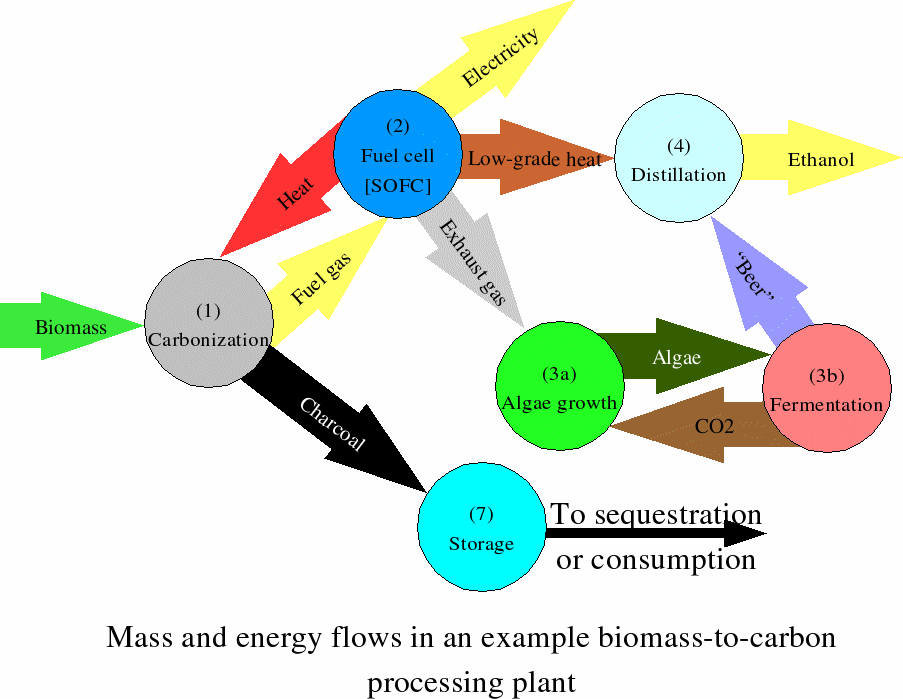
02-03-2007, 09:50 AM
|
|
Ta ra ra boom de ay
|
|
Join Date: Jun 2004
Location: Pittsburgh
Posts: 1,915
|
|
|
...excerpt
"First thing, you turn the biomass into charcoal. This doesn't take sophisticated equipment; it can be made simple, rugged and cheap (though it can always be improved). The process takes biomass and compressed air (or heated gas of some kind). Its products are:
Hot medium-BTU fuel gas (the content of heavy molecules such as tars depends on the operating conditions; hotter operation breaks down heavier molecules).
Charcoal, amounting to as much as 30% of the dry weight of the input biomass.
A 30% (ashless) yield of carbon would contain about 50% of the energy of the original biomass. The remaining 50% would come off as heat and chemical energy in the gas. The simplest processes for making charcoal do it by burning some of the input fuel, but this can be improved. If the carbonization process was driven partly by external or recycled heat, less energy would be expended in combustion; the net energy yield in the gas would shift away from heat toward chemical energy (and total energy yield of charcoal+gas could exceed 100% of the heat of combustion of the biomass). Medium-BTU gas isn't easily transported, but it can be used at the site of production to good effect.
There are several uses for fuel gas, but one of the best is making electricity. Hot combustible gas is more or less what an SOFC runs on. GE and Delphi have been developing small SOFC's for automotive applications, and both recently beat the $300/kW price barrier. Efficiency is 49% and headed upward. If we assume that:
1.72 billion tons per year of biomass is carbonized.
This biomass has 15.8 million BTU/dry ton of energy (27.1 quads total energy).
53.5% of the energy is yielded as charcoal (30% by weight).
88% of the remainder is yielded as chemical energy in hot gas (11.1 quads gas + 1.51 quads reaction heat + recycled heat).
The gas can be converted to electricity at 50% efficiency.
The electric yield from the processing of the gas would be 5.55 quads, or 1620 billion kilowatt-hours. This is more than twice the US electric generation from natural gas (~750 billion kWh), and more than 1/2 of the total US electric generation from all fossil fuels. In short, all non-renewable natural gas generation could be replaced by energy from the carbonization stage, and a large chunk of the coal-fired generation as well.
But that's not the end of it! The process also produces charcoal; at 30% yield, 1.72 billion tons of input would leave about 515 million tons of output. Charcoal can be used for fuel, as a soil amendment or as a feedstock for further processing. Gasified charcoal would produce fewer pollutants than gasified coal and could be used for power generation or production of nitrogen fertilizer. But the most efficient option appears to be use in direct-carbon fuel cells (DCFC's). Up to 80% of the chemical energy of the charcoal can be turned into electricity in DCFC's (and the byproduct heat is still useful).
Charcoal is like coal, only more stable. Charcoal is the product of a high-temperature process, and is missing most of the hydrogen and volatile chemicals of coal. It can be heaped and stored for weeks to thousands of years; charcoal from ancient forest and camp fires allows prehistoric events to be dated. It is a valuable addition to soil, creating the fertile "terra preta"4 of the notoriously nutrient-poor Amazon rainforest. It's perhaps the ultimate answer to irregular supplies of renewable energy. An annual supply of 515 million short tons of charcoal fed to DCFC's would produce roughly 3400 billion kilowatt-hours of energy. This is more than the total US generation from fossil fuels, and about 84% of the total electric energy consumed in the USA in 2005; together with the generation from the gas, it could conceivably replace every kilowatt-hour we now use, from the trivial amounts made by solar to the entire contribution of coal, with about 25% extra to play with.
It wouldn't be wise to replace everything with biomass energy, of course; throwing away diversity of supply means reducing security. But it shows just how much potential we've got, if we only start using it."

Last edited by A264172; 02-05-2007 at 12:30 PM.
|